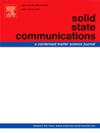先进光电应用Cs2AuMoX6 (X = Cl, Br)的力学和电子特性的综合DFT研究
IF 2.1
4区 物理与天体物理
Q3 PHYSICS, CONDENSED MATTER
引用次数: 0
摘要
本文利用密度泛函理论(DFT)研究了双包晶石 Cs2AuMoX6(X = Cl、Br)的机械、光电和传输特性。我们证实,Cs2AuMoCl6 和 Cs2AuMoBr6 均采用稳定的立方晶体结构,公差系数(τ,0.97 和 0.95)略微偏离统一。负形成自由能和吉布斯自由能用于验证它们在实际应用中的热力学稳定性。考虑到弹性特性,观察到脆性内的机械稳定性和各向异性行为。电子能带结构计算表明,Cs2AuMoCl6 的间接能带隙为 1.4 eV,而 Cs2AuMoBr6 的直接能带隙为 0.8 eV。对这些化合物的评估表明,这些带隙适合它们在光电和光电子领域的应用。包括光吸收、偏振和折射率在内的光学特性在可见光区域表现出很强的吸收性,这使这些材料成为光电应用的理想候选材料。基于 BoltzTraP 代码预测的计算表明,Cs2AuMoCl6 和 Cs2AuMoBr6 的热电功勋值(ZT)分别为 0.73 和 0.72。这些结果表明,Cs2AuMoX6 化合物可应用于可持续能源领域。本文章由计算机程序翻译,如有差异,请以英文原文为准。
Communicated by: FrancoisComprehensive DFT investigation of mechanical and electronic properties in Cs2AuMoX6 (X = Cl, Br) for advanced optoelectronic applications
This article investigated the mechanical, optoelectronic, and transport properties of the double perovskites Cs2AuMoX6 (X = Cl, Br) using density functional theory (DFT). We confirm that both Cs2AuMoCl6 and Cs2AuMoBr6 adopt a stable cubic crystal structure with slightly off unity tolerance factors (τ, 0.97 and 0.95). Negative formation and Gibbs free energies were used to validate their thermodynamic stability them for practical applications. Mechanical stability within a brittle nature and anisotropic behavior were observed in consideration of elastic properties. Electronic band structure calculations indicated Cs2AuMoCl6 has indirect band gaps of 1.4 eV while Cs2AuMoBr6 possesses 0.8 eV direct band gaps. Evaluation of these compounds suggests that these are appropriate band gaps for their application in photovoltaic and optoelectronics. The optical properties, including light absorption, polarization, and refractive index, exhibited strong absorption in the visible region, which renders these materials good candidates for photovoltaic applications. Calculations based on the BoltzTraP code predictions suggest modest thermoelectric figures of merit (ZT) of 0.73 and 0.72 for Cs2AuMoCl6 and Cs2AuMoBr6, respectively. These results demonstrate that Cs2AuMoX6 compounds may find applications in sustainable energy.
求助全文
通过发布文献求助,成功后即可免费获取论文全文。
去求助
来源期刊

Solid State Communications
物理-物理:凝聚态物理
CiteScore
3.40
自引率
4.80%
发文量
287
审稿时长
51 days
期刊介绍:
Solid State Communications is an international medium for the publication of short communications and original research articles on significant developments in condensed matter science, giving scientists immediate access to important, recently completed work. The journal publishes original experimental and theoretical research on the physical and chemical properties of solids and other condensed systems and also on their preparation. The submission of manuscripts reporting research on the basic physics of materials science and devices, as well as of state-of-the-art microstructures and nanostructures, is encouraged.
A coherent quantitative treatment emphasizing new physics is expected rather than a simple accumulation of experimental data. Consistent with these aims, the short communications should be kept concise and short, usually not longer than six printed pages. The number of figures and tables should also be kept to a minimum. Solid State Communications now also welcomes original research articles without length restrictions.
The Fast-Track section of Solid State Communications is the venue for very rapid publication of short communications on significant developments in condensed matter science. The goal is to offer the broad condensed matter community quick and immediate access to publish recently completed papers in research areas that are rapidly evolving and in which there are developments with great potential impact.
 求助内容:
求助内容: 应助结果提醒方式:
应助结果提醒方式:


